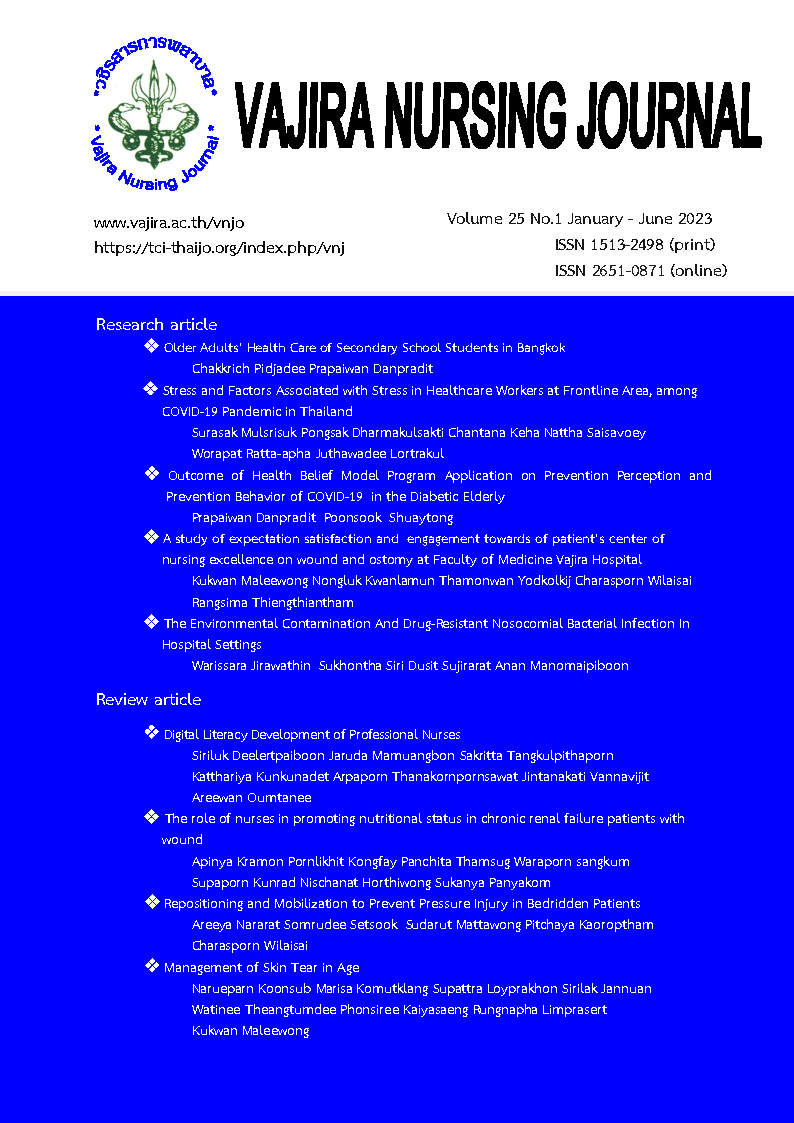การปนเปื้อนของเชื้อแบคทีเรียในสิ่งแวดล้อม และการติดเชื้อแบคทีเรียดื้อยาต้านจุลชีพในโรงพยาบาล
Main Article Content
บทคัดย่อ
การศึกษานี้มีวัตถุประสงค์เพื่อศึกษาความชุกของเชื้อแบคทีเรียก่อโรคที่ดื้อยาในอากาศภายในอาคารและพื้นผิวที่สัมผัสบ่อยโรงพยาบาลวชิรพยาบาล คณะแพทยศาสตร์มหาวิทยาลัยนวมินทราธิราช ศึกษาความสัมพันธ์ระหว่างปริมาณแบคทีเรีย ชนิด และตัวแปรทางกายภาพกับความชุกของการติดเชื้อแบคทีเรียดื้อยาในโรงพยาบาล ตัวอย่างอากาศ 442 ตัวอย่าง และสวอบพื้นผิว 1,212 ตัวอย่างจาก 41 หอผู้ป่วย ตัวอย่างอากาศเก็บด้วยเครื่อง MAS-100® impactor วิเคราะห์ข้อมูลโดยสถิติเชิงพรรณนาและสมการถดถอยปัวซอง เพื่อระบุความสัมพันธ์ระหว่างปัจจัยเสี่ยงกับการติดเชื้อแบคทีเรียดื้อยาในโรงพยาบาลที่ระดับนัยสำคัญ p<.05 ผลการศึกษาพบว่า Carbapenem-resistant A. baumannii (CRAB) เป็นแบคทีเรียดื้อยาที่พบมากในอากาศและพื้นผิวที่สัมผัสบ่อย การปนเปื้อนของแบคทีเรียดื้อยาในอากาศและพื้นผิวที่สัมผัสบ่อยพบมากที่สุดในหอผู้ป่วยอายุรกรรมตัวอย่างที่พบการปนเปื้อนมากที่สุดมาจากผ้าพันแขนวัดความดัน นอกจากนี้จำนวนผู้ป่วยติดเชื้อแบคทีเรียดื้อยาในโรงพยาบาลที่สอดใส่อุปกรณ์ทางการแพทย์จำนวน 9 ราย อัตราการติดเชื้อเท่ากับ 0.67 ครั้ง ต่อ 1,000 วันนอน การติดเชื้อแบคทีเรียดื้อยาในโรงพยาบาลมีความสัมพันธ์กับการปนเปื้อน CRAB ในอากาศ และพื้นผิวที่สัมผัสบ่อย จำนวนบุคลากรทางการแพทย์ และความชื้นสัมพัทธ์ภายในหอผู้ป่วยอย่างมีนัยสำคัญทางสถิติ (p<.001) การศึกษานี้จะช่วยในการพัฒนาแนวทางสำหรับลดการติดเชื้อในโรงพยาบาล
Article Details

อนุญาตภายใต้เงื่อนไข Creative Commons Attribution-NonCommercial-NoDerivatives 4.0 International License.
เนื้อหาและข้อมูลในบทความที่ลงตีพิมพ์ในวชิรสารการพยาบาลถือเป็นข้อคิดเห็นและความรับผิดชอบของผู้เขียนบทความโดยตรง ซึ่งกองบรรณาธิการไม่จำเป็นต้องเห็นด้วย หรือร่วมรับผิดชอบใด ๆ ทั้งสิ้น
บทความ ข้อมูล เนื้อหา รูปภาพ ฯลฯ ที่ได้รับการตีพิมพ์ในวชิรสารการพยาบาล ถือเป็นลิขสิทธิ์ของวชิรสารการพยาบาล หากบุคคลใดหรือหน่วยงานใดต้องการนำทั้งหมดหรือส่วนหนึ่งส่วนใดไปเผยแพร่ต่อหรือเพื่อกระทำการใด ๆ จะต้องได้รับอนุญาตเป็นลายลักอักษรจากวชิรสารการพยาบาลก่อนเท่านั้น
เอกสารอ้างอิง
Centers for Disease Control and Prevention. Healthcare-associated infections (HAIs) [Internet].2016 [cited 10April 2019] Available from:https:// www.cdc.gov/hai/infection types.html
Allegranzi B, Nejad SB, Combescure C, Graafmans W, Atta H, Donaldson L, et al. Burden of endemic health-care-associated infection in developing countries: systematic review and meta-analysis. Lancet 2011; 377 (9761): 228-241.
Ling ML, Apisarnthanarak A, Madriaga G. The burden of Healthcare-associated infections in Southeast Asia: A systematic review and meta-analysis. Clin Infect Dis 2015; 60(11): 1690-1699.
Manosuthi W, Thientone V, Moolasart V, Tongrungrueng Y, Sangsajja, Danchaivijitr S. Healthcare-associated infections at selected hospitals in Thailand. Southeast Asian J Trop Med Public Health 2017; 48 (1): 204-212.
Haque M, Sartelli M, McKimm J, Bakar MA. Healthcare-associated infections –an overview. Infect Drug Resist 2018; 11: 2321-2333
Tacconelli E, Cataldo MA, Dancer SJ, Angelis GD, Falcone M, Frank U. ESCMID guidelines for the management of the infection control measures to reduce transmission of multidrug-resistant Gram-negative bacteria in hospitalized patients. Clin Microbiol Infect 2014; 20 (s): 1-55.
Sumpradit N, Suttajit S, Poonplosup S, Chuancheun R, Prakongsai P. Landscape of antimicrobial resistance situation and action in Thailand. Bangkok: Aksorn graphic and design; 2558.
Phumart P, Phodha T, Thamlikitkul V, Riewpaiboon A, Prakongsai P, Limwattananon S. Health and economic impacts of antimicrobial resistant infections in Thailand: a preliminary study. JHSR 2012; 6: 352-360.
Jeong JY. Recently issues on indoor air quality in Korea [Internet]. 2015 [cited 10 May 2019]. Available from: https://pdfs. semanticscholar.org/ edb2/7018fc8586ed8754df50d5afc 8af5d226d51.pdf.
Rozanska A, Romaniszyn D, Chmielarczyk A, Bulanda M. Bacteria contamination of touch surfaces in Polish hospital wards. Med Pr 2017; 68(4): 459-467.
Yassin MF, Almouqatea S. Assessment of airborne bacteria and fungi in an indoor and outdoor environment. Int J Environ Sci Tech 2010; 7: 535-544.
Khan HA, Baig FK, Mehboob R. Nosocomial infections: Epidemiology, prevention, control and surveillance. Asian Pac J Trop Biomed 2017; 7(5): 478-482.
Gizaw Z, Gebrehiwot M, Yenew C. High bacterial load of indoor air in hospital wards: the case of University of Gondar teaching hospital, Northwest Ethiopia. Multidiscip Respir Med 2016;11:24.
Munoz-Price S, Fajardo-Aquino Y, Arheart K, Cleary T, DePascale D, Pizano L, et al. Aerosolization of Acinetobacter baumannii in a Trauma ICU. Crit Care Med 2013; 41 (8): 1915-1918.
Solomon FB, Wadilo F, Tufa EG, Mitiku M. Extended spectrum and metalo beta- lactamase producing airborne Pseudomonas aeruginosa and Acinetobacter baumanii in restricted settings of a referral hospital: a neglected condition. Antimicrob Resist Infect Control 2017; 6: 1-7.
Creamer E, Shore AC, Deasy EC, Galvin S, Dolan A, Walley N, et al. Air and surface contamination patterns of methicillin-resistant Staphylococcus aureus on eight acute hospital wards. J Hosp Infect 2014; 86(3): 201-208.
Sui W, Wang J, Wang H, Wang M, Huang Y, Zhuo J, et al. Comparing the transmission potential of Methicillin-resistant Staphylococcus aureus and multidrug-resistant Acinetobacter baumannii among inpatients using target environmental monitoring. Am J Infect Control 2013; 41: 411-415.
Yosboonruang A, Jitsatthra C, Tharawet L. Incidence of resistant bacteria isolated from medical devices in the intensive care unit of a hospital.J Public Health (Bangkok) 2017; 47: 222-234.
Muzslay M, Moore G, Turton JF, Wilson AP. Dissemination of antibiotic-resistant enterococci within the ward environment: The role of airborne bacteria and the risk posed by unrecognized carriers. Am J Infect Control 2013; 41(1): 57-60.
Rocha IV, Xavier DE, Almeida KRH, Oliveira SR, Leal NC. Multidrug-resistant Acinetobacter baumannii clones persist on hospital inanimate surfaces. Braz J Infect Dis 2018; 22(5): 438-441.
Smith J, Adams CE, King MF, Noakes CJ, Robertson C, Dancer SJ. Is there an association between airborne and surface microbes in the critical care environment?. J Hosp Infect 2018; 100(3): e123-9.
Russotto V, Cortegiani A, Raineri SM, Giarratano A. Bacterial contamination of inanimate surfaces and equipment in the intensive care unit. J Intensive Care 2015; 3: 54.


